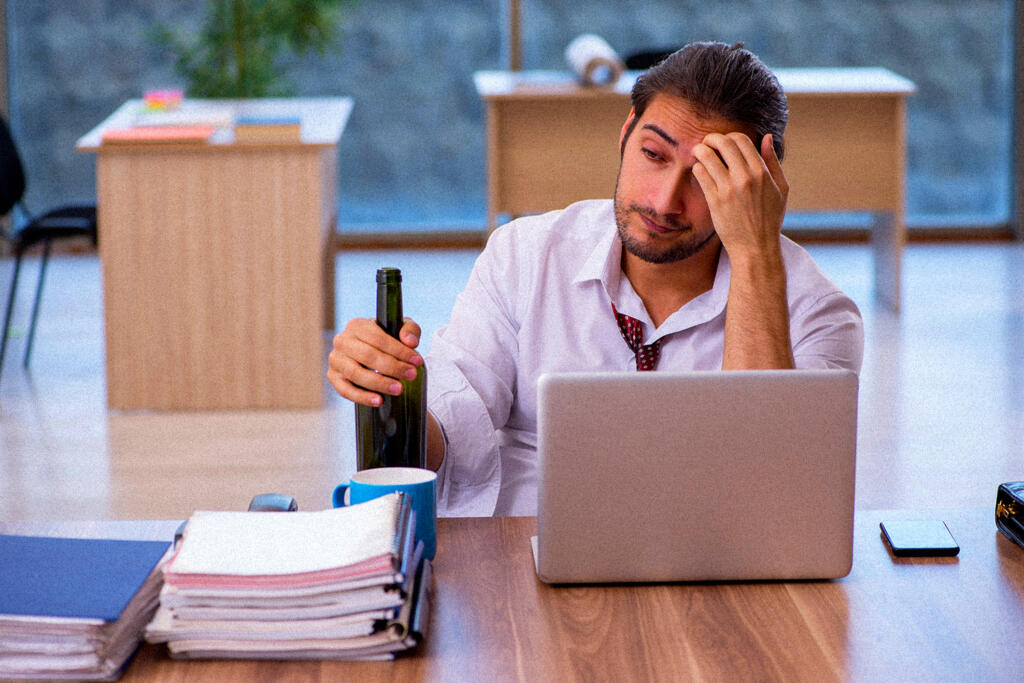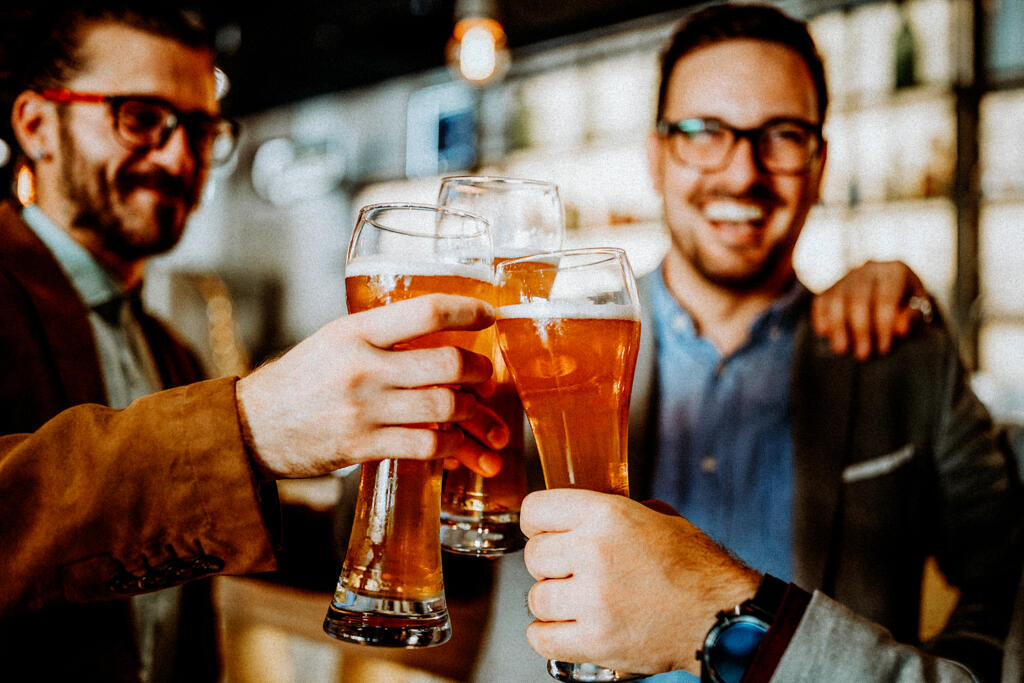Craving a pint in between emails? Wish you could finish off your boring office meeting with a sneaky shot or two? You’re not alone. Here’s everything you need to know about drinking at work…
Shows like Mad Men, which happily shows business leaders enjoying a nice glass of whiskey in between meetings, have left a lot of us wondering why perceptions of drinking at work have changed over the years.
While alcohol at work used to be commonplace, that’s rarely the case today.
Tell someone that you’ve been drinking in the workplace these days, and you’ll be met with one of two responses. Either the lads will tell you that you’re a lucky bastard with a great boss, or they’ll drag you kicking and screaming to an AA meeting.
However, drinking on the job doesn’t have to be something that’s linked to either a lax boss or an alcohol addiction. There are plenty of people who consider drinking while working to be a positive thing, as long as you do it properly.
Drinking on the job: A hazy history

The presence of alcohol at work was a pretty common image for the male-dominated workplaces of the 1950s and 60s.
In the Mad Men era, countless business people used to start their lunches with a round of Manhattans or a few dirty martinis. Executives stumbled back to their offices in high spirits and enjoyed a nip or two of scotch after 3 to keep them going until home time.
While we often associate drinking at work with the 60s, the truth is that it actually goes back a lot further than you think. Just like at the good old’ US for instance.
A lot of Americans used to get paid in things like brandy and whisky when money was in short supply, and people in hands-on careers relied on alcohol to give them strength when they were running out of motivation.
Unfortunately, in the 1970s, our perception of drinking while working started to change.
Cuts in entertainment and meal tax deductions meant that business leaders could no longer afford to take clients out for boozy afternoon meals. What’s more, we all started to see alcohol a little differently.
In America, a study discovered that people started to consider people who chose beer over soft drinks at work meetings were often considered to be stupider than people who picked soft drinks.
Something as simple as ordering a beer at a meeting with your boss could be enough to lead to an awkward conversation with HR about in-office conduct.
So, what happened?
The new era of alcohol at work
The benefits of drinking
Let’s face it, getting drunk at work probably isn’t a good idea most of the time.
Alcohol makes it harder for us to make decisions, damages our focus, and makes us more susceptible to accidents. Depending on what you do at the office, a few pints at lunch could mean that you’re more likely to spend more of your afternoon napping than finishing projects.
However, does that really mean that we shouldn’t be drinking in the office at all?
Probably not.
A pint with pals when you’re on your lunch break isn’t going to instantly make you into a terrible employee. We’re beginning to see a number of benefits to drinking in the workplace.
For instance, alcohol at work can lead to:
Improved opportunities for team bonding
Alcohol is a fantastic social lubricant. It’s much easier to ignore how annoying you find Bob’s toupee when you’ve had a nice glass of Guinness.
Drinking with your coworkers at lunch can give you an excellent opportunity to build stronger relationships with people who you’d otherwise avoid at all costs.
Since alcohol also has a habit of lowering our inhibitions, it can also push us to step out of that pesky comfort zone and connect with new people.
Better recruitment and retention
Who wouldn’t prefer to work in an office where cocktails are on the menu every Friday?
As employers search for new ways to attract new employees with various perks and new ideas, in-house happy hours are becoming increasingly appealing.
You don’t have to encourage your team members getting drunk at work to take advantage. The occasional beer on a Friday afternoon could be all it takes to create a happier workplace.
Improved feelings of respect
Telling your colleagues that they can drink alcohol if they choose to do so shows that you respect them. It’s basically like saying “I know you’re an adult, and you’re going to make responsible decisions”.
Adding alcohol to the menu for your office lunches shows your employees that you’re willing to treat them like an equal, and trust that they know their limits.
The changing nature of drinking while working
Although not every company has embraced the idea that drinking at work is a positive thing yet, we are moving further in that direction.
For example, Yelp’s headquarters in San Francisco has its own keg refrigerator that supplies employees with all the beer they could want.
There’s another company, called the Arnold Worldwide Ad Agency, that also has its own beer vending machine that the colleagues refer to as “Arnie”.
Bringing drinking on the job into the workplace in a healthy way helps to combine after-hours personal activities with the professional environment – in a positive way.
It can even help to keep employees around for longer if you’re trying to convince them to take part in team-building exercises.
The key to success is approaching the concept correctly.
As an employee, you need to decide how much indulgence is going to be acceptable, and how you can make sure that you adhere to the company culture, without being weird about it.
Let’s say your employer introduces workplace happy hours into the office, then there’s nothing wrong with agreeing to have a pint at lunch. However, you might get some weird looks if you become the guy that orders 5 martinis with every round.

How to drink at work
So, how do you drink at work – the right way?
Well, the first step to drinking at work is to know your limits. Remember that you do still have a job to do. If drinking a couple of pints is going to make it hard for you to concentrate, then it’s best to say no.
Alternatively, you might take part in office drinking later in the day, when you know you have fewer crucial facts to focus on.
Other tips to follow include:
Stick to beer
Whisky on the rocks might look cool but it’s not a good idea.
Beers have around 6% alcohol content, which means that you should be able to stay in control of your drinking.
Spirits and wines are a lot harder to manage – particularly when you’re surrounded by other people who are drinking too.
Eat with your booze
If possible, it’s best to have alcohol at work with food. Grab a beer when you go for lunch, and the food will help to soak up some of the booze.
That way, there’s less of a chance that you’re going to end up getting wild and tipsy when you’re meeting with clients later on.
Follow the golden rules of drinking
In other words, stop when you’re ahead. One drink per hour is usually more than enough.
Don’t make it into a competition of who can drink the most with your coworkers.
Additionally, for the love of Chuck Norris, don’t ever drink and drive. If you’re going to be drinking at work, get the metro or other public transport home.
Don’t pressure anyone else
Just because you’re drinking doesn’t mean that anyone else wants to.
There are going to be people in your office who don’t want to drink at work – and that’s fine. They shouldn’t be left out of the conversation just because they’re not drinking, and you should never make someone feel bad for saying no.
Follow the rules
Every office is likely to have its own guidelines in place for how to safely drink at work without looking like an alcoholic. Find out what your bosses expect from you and stick to the rules.
Having a pint or two at work doesn’t have to be a bad thing.
Ultimately, it’s all about remembering that common sense will always rule the day. Stay relaxed and social without becoming that annoying guy that’s yelling in the pizza shop at 2 am on a Friday night.
You got this.
Blitz yourself better!
Now read these:
—Why food deserts are a problem.
—Is coffee bad for your skin?
—What are the benefits of celery juice?
—Are plant based diets effective?
—Your guide to health supplements.
